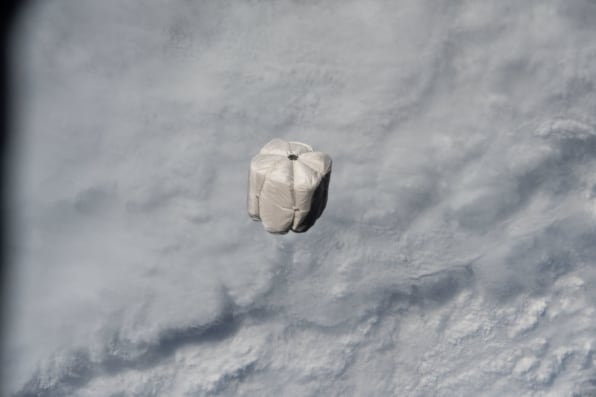Astronauts are taking out the ISS trash using Bishop Airlock
Bishop Airlock’s backstory
Operation Take Out the Trash (that’s an unofficial working title) represented the first full open-close cycle of Bishop. According to Nanoracks, Bishop offers five times the current volume of what can be moved in and out of the ISS. It can support up to 144 units of payloads simultaneously (1 unit equals 10 by 10 by 10 centimeters).
Bishop is the “first commercially funded element” added to “the ISS stack,” Read noted. Shaped like a bell jar, the airlock launched on a SpaceX resupply mission in December 2020 and was commissioned in February 2021. Since then, “all of the core systems have been operating nominally,” Read said.
Key Bishop Airlock design elements
- Bishop can support space walks, satellite deployments, and payload hosting.
- It has external hosting capabilities and a “pretty universal mounting capability,” Read said, with six external sites. The same standardized approach extends to Bishop’s racks, lockers, and electrical interfaces.
- With soft-stowed configurations and pressurized hosting opportunities, the module is also poised to make “payload developers’ lives easier,” according to Read.
- Bishop Airlock can support experiments in partial-pressure environments. Nanoracks can “pump it down to a pressure so it’s not in a vacuum,” Read explained, potentially allowing users to simulate a lunar or Martian environment for experiments.
- The airlock opens up commercial use cases and scientific experiments not previously feasible because they might have been a crew hazard.
Start small, then ramp up
Nanoracks and parent Voyager Space Holdings are “in talks with multiple other companies, public and private” to use Bishop Airlock, Read said. And next year, NASA will begin the Space Entanglement and Annealing QUantum Experiment (or SEAQUE), a quantum computing demo hosted on Bishop.
Nanoracks has gained loads of flight heritage by iterating over time. It “started small, then ramped up,” Read said, graduating from CubeSat deployers to locker-size platforms inside the ISS to a “small external platform on the Japanese-exposed facility” to Bishop.
Bishop will eventually detach from the ISS and join Starlab, a free-flying low Earth orbit (LEO) outpost owned and operated by Voyager and Lockheed Martin. “There are lots of things we’ve learned along the way that will help us with Starlab and building up that station,” Read said.
Bishop Airlock’s backstory
Operation Take Out the Trash (that’s an unofficial working title) represented the first full open-close cycle of Bishop. According to Nanoracks, Bishop offers five times the current volume of what can be moved in and out of the ISS. It can support up to 144 units of payloads simultaneously (1 unit equals 10 by 10 by 10 centimeters).

Bishop is the “first commercially funded element” added to “the ISS stack,” Read noted. Shaped like a bell jar, the airlock launched on a SpaceX resupply mission in December 2020 and was commissioned in February 2021. Since then, “all of the core systems have been operating nominally,” Read said.
Key Bishop Airlock design elements
- Bishop can support space walks, satellite deployments, and payload hosting.
- It has external hosting capabilities and a “pretty universal mounting capability,” Read said, with six external sites. The same standardized approach extends to Bishop’s racks, lockers, and electrical interfaces.
- With soft-stowed configurations and pressurized hosting opportunities, the module is also poised to make “payload developers’ lives easier,” according to Read.
- Bishop Airlock can support experiments in partial-pressure environments. Nanoracks can “pump it down to a pressure so it’s not in a vacuum,” Read explained, potentially allowing users to simulate a lunar or Martian environment for experiments.
- The airlock opens up commercial use cases and scientific experiments not previously feasible because they might have been a crew hazard.
Start small, then ramp up
Nanoracks and parent Voyager Space Holdings are “in talks with multiple other companies, public and private” to use Bishop Airlock, Read said. And next year, NASA will begin the Space Entanglement and Annealing QUantum Experiment (or SEAQUE), a quantum computing demo hosted on Bishop.
Nanoracks has gained loads of flight heritage by iterating over time. It “started small, then ramped up,” Read said, graduating from CubeSat deployers to locker-size platforms inside the ISS to a “small external platform on the Japanese-exposed facility” to Bishop.
Bishop will eventually detach from the ISS and join Starlab, a free-flying low Earth orbit (LEO) outpost owned and operated by Voyager and Lockheed Martin. “There are lots of things we’ve learned along the way that will help us with Starlab and building up that station,” Read said.
